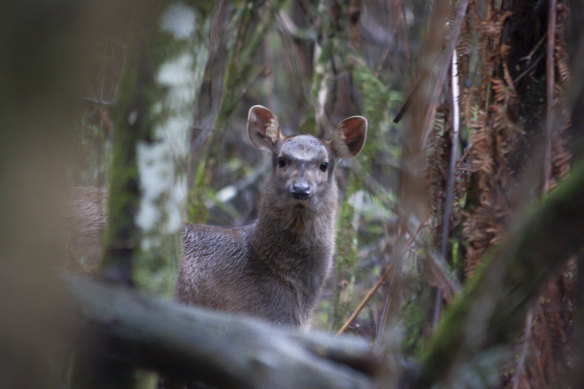Save articles for later
Add articles to your saved list and come back to them any time.
The federal government has drawn a line in the sand for feral deer across much of Victoria, NSW and Queensland in a radical new plan that will establish zones where populations will be eradicated in a bid to prevent their spread from the east coast across the continent.
The new National Feral Deer Action Plan, released on Monday, outlines 22 actions to improve feral deer management in Australia that will stop the spread of large populations and reduce their impact.
A feral deer in Sherbrooke Forest, Victoria.Credit: Alex Maisey
Invasive Species Council spokesperson Dr Tiana Pirtle said the action plan was a potential game changer in stopping the spread of deer.
“The proposal to establish a national containment zone to stop the westward spread of feral deer is our best chance to stopping wall-to-wall deer across the continent. Feral deer have already taken over most natural areas on the east coast. Scientists now predict that, without serious action, feral deer will inhabit nearly every habitat across Australia.”
She added that the containment line would only be successful if state and federal governments worked together to ensure the program was adequately funded.
Many of the deer had already impacted World Heritage areas including in Tasmania, the Blue Mountains, the Gondwana Rainforests of northern NSW and southern Queensland and the Queensland Wet Tropics, she said.
The feral deer population in Australia has probably reached more than 2 million, and the animals are prolific breeders. In good conditions, deer populations can increase by up to 50 per cent each year, meaning that a small herd of 30 deer can grow to 500 in 10 years.
The containment zones will see parts of the country split into four areas. Those in the orange zone have been deemed the biggest threat – which includes large parts of Victoria, NSW and parts of Queensland – and will be eradicated.
In some areas, tree guards might be installed around threatened plants where culling is not effective. In other cases, sound or light deterrents may be used.
The green zone will aim to prevent deer from spreading to these areas, and managing the populations that have established themselves. Management in these areas will be co-ordinated under a national program and facilitated by a co-ordinator and in collaboration with local and state initiatives and agencies. The black zone marks areas where deer are of no concern.
Ted Rowley, chairman of the National Feral Deer Action Plan Committee said collaboration across all levels of government and community was needed to ensure the spread of feral deer was managed.
Peter Jacobs, Invasive Species Council Officer in Victoria added that deer in his state and Tasmania were still legally protected as a game animal, reflecting an outdated attitude to a serious invasive species.
“Feral deer overgraze and trample native grasslands and ring-bark native shrubs and trees. They cause erosion and degrade water quality by wallowing in wetlands and streams, impacting the homes of native species like the platypus,” he said.
Federal Minister for Agriculture, Fisheries and Forestry Murray Watt said managing feral animals was key to protecting agricultural industries and the environment. So far, the federal government has invested in $5 million in deer control projects.
Minister for Environment and Water Tanya Plibersek added that feral deer numbers had exploded from 50,000 in 1980 to between 1 and 2 million today.
“They are the next rabbit of Australia’s feral species,” she said. “Feral deer do enormous damage to our native wildlife and precious places – they kill threatened species and damage critical habitat. Our government is committed to protecting our precious species and leaving nature better off for our kids and grandkids.”
A guide to the environment, what’s happening to it, what’s being done about it and what it means for the future. Sign up to our fortnightly Clear Air newsletter here.
Most Viewed in Environment
From our partners
Source: Read Full Article




